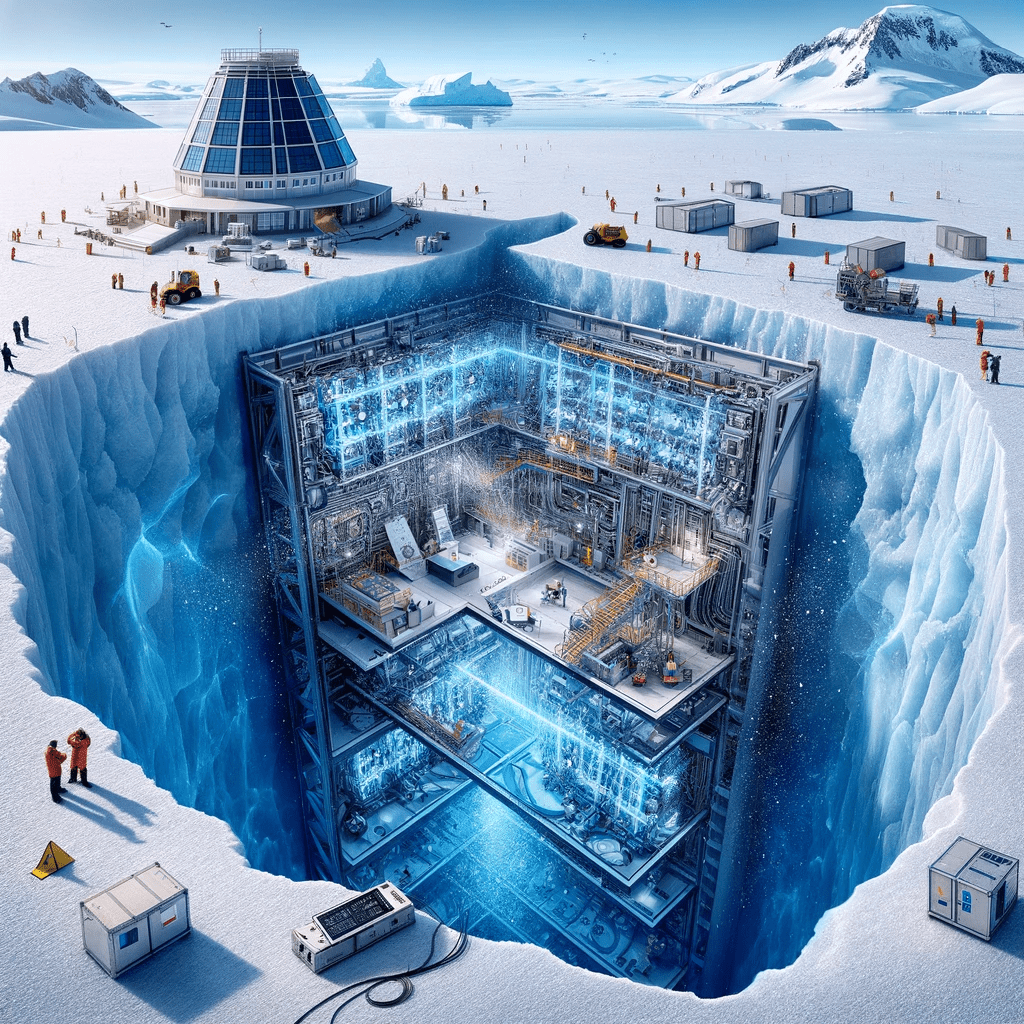Ice Cube Neutrino Detector

In an interview with Dr. Michael Salla for “Exopolitics Today,” Eric Hecker discussed his experiences while working at the South Pole’s Amundsen-Scott Station in Antarctica from October 2010. Employed by Raytheon Polar Services Company, Hecker was involved in maintaining scientific equipment, including the Ice Cube Neutrino Detector. He revealed surprising insights about the Ice Cube’s capabilities, suggesting it functioned not only as a passive recorder of neutrinos but also as a powerful transmitter and potentially the world’s largest directed energy weapon.
The Ice Cube Neutrino Detector, positioned at the South Pole, stands as a state-of-the-art scientific tool specifically developed for observing neutrinos. These subatomic particles are characterized by their extremely low mass and lack of electric charge, making them notoriously elusive as they seldom interact with matter. This detector primarily aims to analyze neutrinos emanating from space, thereby providing valuable insights into various cosmic phenomena and the realm of fundamental physics.
Positioned beneath the Antarctic ice, the Ice Cube Neutrino Detector comprises thousands of optical sensors, known as Digital Optical Modules (DOMs), strategically embedded within a cubic kilometer of ice and arranged in a vast grid pattern. Its detection method revolves around capturing the Cherenkov radiation produced when neutrinos interact with the ice. This interaction, occurring when a neutrino collides with an atomic nucleus in the ice, results in a cascade of secondary particles that emit Cherenkov radiation, visible as blue light. The DOMs detect this light, enabling scientists to deduce the original neutrino’s properties, including its energy and incoming direction.
The detector’s primary scientific objective is to scrutinize high-energy neutrinos originating from the universe’s most intense environments, such as supernovae, black holes, and neutron stars. Studying these neutrinos is expected to deepen our understanding of both these extraordinary cosmic events and the intrinsic properties of neutrinos.
The IceCube Neutrino Detector is an international collaboration project primarily funded and operated by the National Science Foundation (NSF) of the United States. It represents a significant scientific endeavor involving a consortium of institutions from around the world. These include various universities and research institutions from countries such as the USA, Belgium, Germany, Sweden, Switzerland, Japan, New Zealand, Australia, and others.
The project is managed by the IceCube Collaboration, which comprises scientists, engineers, and staff from multiple institutions who contribute to the construction, maintenance, and scientific research of the detector. The University of Wisconsin–Madison has played a leading role in the project, particularly in its coordination and scientific direction.
Raytheon, through its subsidiary Raytheon Polar Services, was indeed involved in supporting operations at the South Pole, specifically at the Amundsen-Scott South Pole Station. This support was part of the United States Antarctic Program (USAP), which Raytheon provided logistical and operational assistance for.
Hecker detailed the diverse applications of Ice Cube, from weather modification and mind control to its involvement in the Christchurch, New Zealand earthquakes in September 2010 and February 2011. His revelations extended to the Ice Cube’s role in deep space communications, potentially connecting with spacecraft beyond our solar system.
If the IceCube Neutrino Detector were repurposed as a transmitter, the Antarctic ice could play a unique role. The ice’s clarity and purity might enhance signal transmission, similar to how it aids neutrino detection. The deep ice drilling techniques used for embedding DOMs (Digital Optical Modules) could be advantageous for installing deep-earth transmission equipment, potentially stabilizing signal emission. Moreover, the extensive array of DOMs, if reconfigured, could theoretically serve as part of a complex transmission network, leveraging their spread across a large area for wide-ranging signal coverage.
Throughout the interview, Hecker reflected on his personal history, including his upbringing as a gifted child, brief service in the US Navy, and involvement in what he believed to be a secret space program. He suspected that his employment with Raytheon, particularly in Antarctica, was a cover for continued service in this covert program, with his memories of specific activities being wiped.
This interview sheds light on Hecker’s journey from a child involved in intelligence programs to his role in Antarctica, raising questions about the true nature and extent of secretive operations in remote and strategically significant locations like the South Pole.

